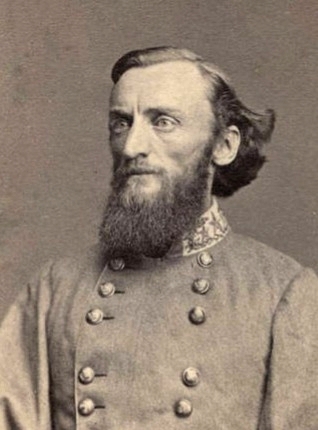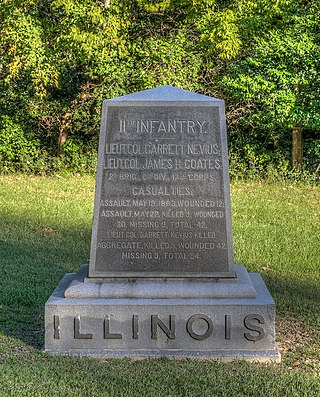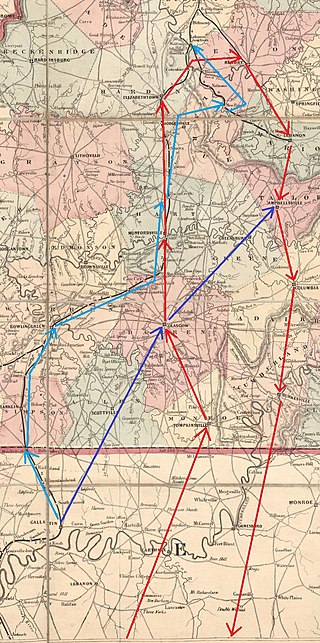Battle
On June 8, 1864, General John Hunt Morgan's Cavalry attacked U.S. forces guarding a vital supply depot at Mount Sterling. The C.S. forces attacked the U.S. Army camp in Mount Sterling under the command of Captain Edward Barlow. The Confederates captured 380 prisoners and material and took $59,000 from Farmers' Bank. Leaving a force under Colonel H. L. Giltner, Morgan moved west with the 2nd Brigade. [1]
Early in the morning on June 9, 1864, U.S. forces under General Stephen G. Burbridge attacked the Confederates camped on Camargo Pike under the command of Colonel R. M. Martin. Colonel H. L. Giltner brought a force from Levee Road to support Martin's besieged men, but both forces were driven back through the town. The Confederate counterattack failed to overcome the opposing force, and losses were incurred on both sides. [1]
The battle continued sporadically throughout the surrounding countryside, leaving relics like ammunition and sabers buried in the ground, some of which are still being found as fields are plowed. The battle ended with the defeat of the outnumbered Confederates, marking the last of the actual fighting for Montgomery County, Kentucky. [2] The aftermath of the battle included 8 killed, 13 wounded for the Confederates and 4 killed, 10 wounded for the United States.

Harrison County is a county located in the U.S. state of Kentucky. As of the 2020 census, the population was 18,692. Its county seat is Cynthiana. The county was founded in 1793 and named for Colonel Benjamin Harrison, an advocate for Kentucky statehood, framer of the Kentucky Constitution, and Kentucky legislator.

John Hunt Morgan was a Confederate general in the American Civil War. In April 1862, he raised the 2nd Kentucky Cavalry Regiment, fought at Shiloh, and then launched a costly raid in Kentucky, which encouraged Braxton Bragg's invasion of that state. He also attacked General William Rosecrans's supply lines. In July 1863, he set out on a 1,000-mile raid into Indiana and Ohio, taking hundreds of prisoners. But after most of his men had been intercepted by U.S. Army gunboats, Morgan surrendered at Salineville, Ohio, the northernmost point ever reached by uniformed Confederates. Morgan carried out the diversionary "Morgan's Raid" against orders, which gained no tactical advantage for the Confederacy while losing the regiment. Morgan escaped prison, but his credibility was so low that he was restricted to minor operations. He was killed at Greeneville, Tennessee, in September 1864. Morgan was the brother-in-law of Confederate general A. P. Hill. Various schools and a memorial are dedicated to him.

The Battle of Mine Creek, also known as the Battle of Little Osage, was fought on October 25, 1864, in Linn County, Kansas, as part of Price's Missouri Campaign during the American Civil War. Major-General Sterling Price had begun an expedition in September 1864 to restore Confederate control of Missouri. After being defeated at Westport near Kansas City on October 23, Price's army began to retreat south through Kansas. Early on October 25, Price's army was defeated at the Marais des Cygnes. After Marais des Cygnes, the Confederates fell back, but were stalled at the crossing of Mine Creek while a wagon train attempted to cross.
The First Battle of Murfreesboro was fought on July 13, 1862, in Rutherford County, Tennessee, as part of the American Civil War. Troops under Confederate cavalry commander Brig. Gen. Nathan Bedford Forrest surprised and quickly overran a Federal hospital, the camps of several small Union units, and the jail and courthouse in Murfreesboro, Tennessee. All of the Union units surrendered to Forrest, and the Confederates destroyed much of the Union's supplies and destroyed railroad track in the area. The primary consequence of the raid was the diversion of Union forces from a drive on Chattanooga.

The Battle of Cove Mountain occurred in Wythe County, Virginia, on May 10, 1864, during the American Civil War. A Union cavalry division commanded by Brigadier General William W. Averell was prevented from attacking a lead mine located near Wytheville. Confederate forces commanded by Brigadier General John Hunt Morgan, with a detachment of a brigade of cavalry from the command of Brigadier General William E. "Grumble" Jones, stopped Averell at Cove Gap, adjacent to Crockett's Cove and Cove Mountain.

John Sappington Marmaduke was an American politician and soldier. He was the 25th governor of Missouri from 1885 until his death in 1887. During the American Civil War, he was a senior officer of the Confederate States Army who commanded cavalry in the Trans-Mississippi Theater.
The Battle of Salineville occurred July 26, 1863, near Salineville, Ohio, during the American Civil War. U.S. Brig. Gen. James M. Shackelford destroyed Confederate Brig. Gen. John Hunt Morgan's remaining Confederate cavalry and captured Morgan, ending Morgan's Raid. It was the northernmost military action involving an official command of the Confederate States Army.
The Camden Expedition was the final campaign conducted by the Union Army in Arkansas during the Civil War. The offensive was designed to cooperate with Major-General Nathaniel P. Banks' movement against Shreveport.

Kentucky was a southern border state of key importance in the American Civil War. It officially declared its neutrality at the beginning of the war, but after a failed attempt by Confederate General Leonidas Polk to take the state of Kentucky for the Confederacy, the legislature petitioned the Union Army for assistance. Though the Confederacy controlled more than half of Kentucky early in the war, after early 1862 Kentucky came largely under Union control. In the historiography of the Civil War, Kentucky is treated primarily as a southern border state, with special attention to the social divisions during the secession crisis, invasions and raids, internal violence, sporadic guerrilla warfare, federal-state relations, the ending of slavery, and the return of Confederate veterans.
The Battle of Salyersville, also called Battle of Ivy Point Hill, also called The Battle of Half Mountain, was the largest of the many skirmishes in Magoffin County, Kentucky, during the American Civil War.
The 9th Michigan Cavalry Regiment was a cavalry regiment that served in the Union Army during the American Civil War.

The Second Battle of Cynthiana included three separate engagements during the American Civil War that were fought on June 11 and 12, 1864, in Harrison County, Kentucky, in and near the town of Cynthiana. This was part of Confederate Brigadier General John H. Morgan's 1864 Raid into Kentucky. The battle ultimately resulted in a victory by Union forces over the raiders and ended Morgan's Last Kentucky Raid in defeat. Morgan's command had previously captured the town in the First Battle of Cynthiana, July 17, 1862.

The Battle of Marion was a military engagement fought between units of the Union Army and the Confederate Army during the American Civil War near the town of Marion, Virginia. The battle was part of Union Maj. Gen. George Stoneman's attack upon southwest Virginia, aimed at destroying Confederate industrial infrastructure near Saltville and Marion. Union Cavalry and Infantry regiments—some 4,500 soldiers in total—left Tennessee on December 17 for southwestern Virginia.

During the American Civil War, most of what is now the U.S. state of Oklahoma was designated as the Indian Territory. It served as an unorganized region that had been set aside specifically for Native American tribes and was occupied mostly by tribes which had been removed from their ancestral lands in the Southeastern United States following the Indian Removal Act of 1830. As part of the Trans-Mississippi Theater, the Indian Territory was the scene of numerous skirmishes and seven officially recognized battles involving both Native American units allied with the Confederate States of America and Native Americans loyal to the United States government, as well as other Union and Confederate troops.
Events from the year 1864 in the United States.

The 64th Virginia Mounted Infantry Regiment was formed from troops raised in Lee, Scott, Wise and Buchanan counties in Virginia for service in the Confederate States Army during the American Civil War. It served as an infantry regiment, a cavalry regiment, and a mounted infantry (dragoon) unit, and had a mixed reputation.

The 11th Regiment Illinois Volunteer Infantry was an infantry regiment from Illinois that served in the Union Army during the American Civil War. In April 1861, it was formed as a three-month volunteer unit, and in July 1861 it was reorganized as a three-year unit, in which role it served until the end of the war. Two of its commanding officers were promoted to brigadier general and led major units during the war. In its first major action at Fort Donelson the regiment suffered terrible losses. The 11th Illinois also fought at Shiloh, Riggins Hill, Vicksburg, First Yazoo City, Second Yazoo City, and Fort Blakely. In April 1863, the 109th Illinois Infantry Regiment was disbanded and its enlisted men transferred into the 11th Illinois. The regiment was mustered out of service in July 1865.

William Henry Powell was an American soldier who fought for the Union in the American Civil War. He was a leader in the iron and nail business before the war, and his leadership abilities proved useful in the military. Powell began as a captain, and quickly ascended to higher roles in the cavalry, including commanding a regiment, a brigade, and then a division. Powell was awarded his country's highest award for bravery during combat, the Medal of Honor, for heroism at Sinking Creek, Virginia, when, as leader of a group of 22 men, he captured an enemy camp and took over 100 prisoners. This was accomplished without the loss of any of his men on November 26, 1862. He was honored with the award on July 22, 1890.

The 18th Texas Infantry Regiment was a unit of volunteers recruited in Texas that fought in the Confederate States Army during the American Civil War. The regiment was enrolled in Confederate service in May 1862 and always campaigned west of the Mississippi River in the region known as the Trans-Mississippi Department. The unit was assigned to the Texas infantry division known as Walker's Greyhounds. The regiment fought at Milliken's Bend, Richmond (La.), and Bayou Bourbeux in 1863 and Mansfield, Pleasant Hill, and Jenkins' Ferry in 1864. The regiment disbanded in mid-May 1865, but its formal surrender date was 26 May 1865.

Morgan's Christmas Raid was carried out by Confederate Brigadier General John Hunt Morgan between December 22, 1862, and January 5, 1863. Morgan intended to cut the supply lines to the Union Army of the Cumberland in Tennessee. The Union used the Louisville and Nashville Railroad, and Morgan had identified two 500-foot (150 m) long trestle bridges at Muldraugh Hill that could be burnt. Morgan's 4,000-strong cavalry force left Alexandria, Tennessee, on December 22 and passed into Kentucky on Christmas Eve, defeating part of the 2nd Michigan Cavalry Regiment near Tompkinsville. They fought and defeated an Indiana cavalry detachment on Christmas Day at Bear Wallow, Barren County. The U.S. Army sent forces under Colonel John Marshall Harlan and Major General Joseph J. Reynolds to try to catch Morgan. However, Morgan used ruses to distract his pursuers. Morgan captured a Union stockade at Bonnieville on December 26 and on December 27 captured Elizabethtown before burning the bridges at Muldraugh Hill.












